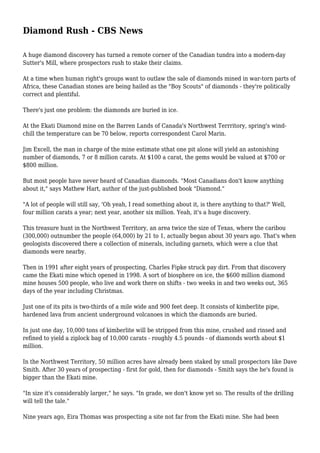
Canadian Diamond Rush Fuels Fifth Largest Industry
- 1. Diamond Rush - CBS News A huge diamond discovery has turned a remote corner of the Canadian tundra into a modern-day Sutter's Mill, where prospectors rush to stake their claims. At a time when human right's groups want to outlaw the sale of diamonds mined in war-torn parts of Africa, these Canadian stones are being hailed as the "Boy Scouts" of diamonds - they're politically correct and plentiful. There's just one problem: the diamonds are buried in ice. At the Ekati Diamond mine on the Barren Lands of Canada's Northwest Terrritory, spring's wind- chill the temperature can be 70 below, reports correspondent Carol Marin. Jim Excell, the man in charge of the mine estimate sthat one pit alone will yield an astonishing number of diamonds, 7 or 8 million carats. At $100 a carat, the gems would be valued at $700 or $800 million. But most people have never heard of Canadian diamonds. "Most Canadians don't know anything about it," says Mathew Hart, author of the just-published book "Diamond." "A lot of people will still say, 'Oh yeah, I read something about it, is there anything to that?' Well, four million carats a year; next year, another six million. Yeah, it's a huge discovery. This treasure hunt in the Northwest Territory, an area twice the size of Texas, where the caribou (300,000) outnumber the people (64,000) by 21 to 1, actually began about 30 years ago. That's when geologists discovered there a collection of minerals, including garnets, which were a clue that diamonds were nearby. Then in 1991 after eight years of prospecting, Charles Fipke struck pay dirt. From that discovery came the Ekati mine which opened in 1998. A sort of biosphere on ice, the $600 million diamond mine houses 500 people, who live and work there on shifts - two weeks in and two weeks out, 365 days of the year including Christmas. Just one of its pits is two-thirds of a mile wide and 900 feet deep. It consists of kimberlite pipe, hardened lava from ancient underground volcanoes in which the diamonds are buried. In just one day, 10,000 tons of kimberlite will be stripped from this mine, crushed and rinsed and refined to yield a ziplock bag of 10,000 carats - roughly 4.5 pounds - of diamonds worth about $1 million. In the Northwest Territory, 50 million acres have already been staked by small prospectors like Dave Smith. After 30 years of prospecting - first for gold, then for diamonds - Smith says the he's found is bigger than the Ekati mine. "In size it's considerably larger," he says. "In grade, we don't know yet so. The results of the drilling will tell the tale." Nine years ago, Eira Thomas was prospecting a site not far from the Ekati mine. She had been
- 2. drilling for days, without any luck, until she took one last sample. That's when she found a 2.5-carat, beautiful, clear, triangular-shaped diamond. Says author Hart, "Eira was 24 years old, a greenhorn prospector with the ink still wet on her geology degree when she stood on melting lake ice in the middle of a huge lake - and the drillers wanting to pull the whole thing down and get the hell to shore - Eira hit the motherload. Her mine, which opens next spring, stands to make $200 to $400 million a year in just rough diamonds. When it does, Canada will be producing a billion dollars worth of Artic or "clean" diamonds a year, so called because they do not come from the war-torn reaches of Africa. The "conflict" or "blood" diamonds come from Angola, Congo and Sierra Leone, where men, women and children were made homeless - and limbless- in wars financed by the diamond trade. Thomas estimates that 96 percent of the world's diamonds are produced from non-conflict areas. Hart calls that "complete baloney." He says those who produce blood diamonds don't keep records or produce auditable returns. Which is why it was impossible, even for Eira Thomas, to tell us, with any certainty, about that two-carat diamond around her neck, a present from her father. Though a tiny percentage of Canadian diamonds are now being microscopically branded, to show where they were mined, virtually all of the world's diamonds are sold with nothing that identifies its country of origin. So if you wanted to buy a non-conflict Canadian diamond in New York's diamond district, it would be just about impossible. And so far, stories about "blood" diamonds and diamond wars in Africa haven't affected diamond sales in the slightest. Says author Hart, "Until the consumers for some reason or other rise up and say, 'You know what? Like, I don't need a diamond that badly. Until you can prove to me where the diamonds come from, I'm not gonna buy them.' If that happened, you bet there'd be a clean diamond stream in no time at all. But it hasn't happened yet." Even though Canada has just one mine in operation, it is already the fifth-largest producer of quality diamonds in the world. But don't expect the price to go down when Eira Thomas' mine opens next year. "New producers, just like old ones, want to keep the price high and the message( A diamond is forever. A diamond is love. A diamond is romance.) one we all remember," says Hart. Everyone knows those images are marketing games but the games work: Eighty-five percent of American women are said to own at least one diamond. "They basically have convinced people to buy a product worth nothing," says Hart. "You can't drive it. You can't make it into clothes. You can't roof your house with it. It's just a fantastically wonderful, glorious blaze of something that has no value whatever except that it looks really great." Copyright 2002 CBS. All rights reserved.